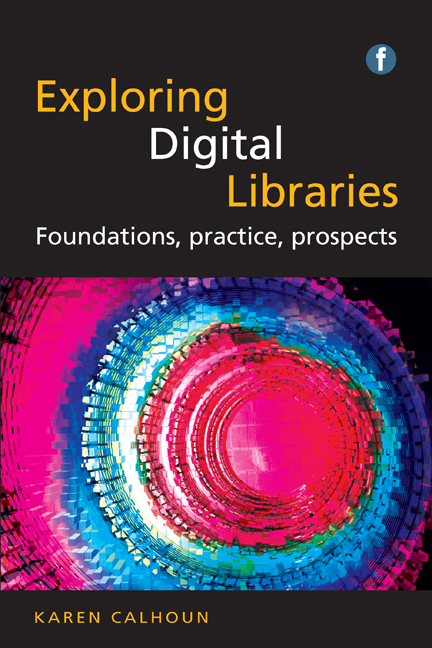Book contents
- Frontmatter
- Dedication
- Contents
- List of figures and tables
- Preface
- Acknowledgements
- Glossary
- 1 Emergence and definitions of digital libraries
- 2 Outcomes of digital libraries’ first decade
- 3 Key themes and challenges in digital libraries
- 4 Digital library collections: repositories
- 5 Hybrid libraries
- 6 Social roles of digital libraries
- 7 Digital libraries and their communities
- 8 The prospects of open access repositories
- 9 Digital libraries and the social web: scholarship
- 10 Digital libraries and the social web: collections and platforms
- References
- Index
10 - Digital libraries and the social web: collections and platforms
Published online by Cambridge University Press: 08 June 2018
- Frontmatter
- Dedication
- Contents
- List of figures and tables
- Preface
- Acknowledgements
- Glossary
- 1 Emergence and definitions of digital libraries
- 2 Outcomes of digital libraries’ first decade
- 3 Key themes and challenges in digital libraries
- 4 Digital library collections: repositories
- 5 Hybrid libraries
- 6 Social roles of digital libraries
- 7 Digital libraries and their communities
- 8 The prospects of open access repositories
- 9 Digital libraries and the social web: scholarship
- 10 Digital libraries and the social web: collections and platforms
- References
- Index
Summary
Overview
This chapter continues the consideration of digital libraries’ responses to the social web. It builds on the visual framework introduced in Chapter 9 to consider the transition of digital collections to platforms that align well with how people find information, work and play on the social web; are highly visible and invite interaction; and re-mix and re-use data from other sources. The chapter closes with some thoughts about future digital libraries and libraries’ digital future.
Visualizing the shift from collections to platforms
The starting point for this chapter is Figure 9.2 (p. 215), specifically the branches that pertain to the shift of digital libraries from collections to platforms. Figure 10.1 offers a closer look at these branches and individual sections of this chapter discuss each branch. The left side of Figure 10.1 visualizes the current situation; the right side visualizes some innovations, experiments or possibilities.
The dilemma of the national or local collections focus
The dilemma
The builders and maintainers of real-world digital libraries face a dilemma that comes from two sources:
• core assumptions about digital libraries as destination sites, complete in themselves
• the tension between who uses digital libraries and who pays for them.
Digital library builders constructed the first wave of digital libraries at national or local institutional levels, or scholarly publishers built them to move their content online. As the web grew up around them, second-wave initiatives and technologies to give digital libraries web interfaces and to make them more interoperable with each other developed (like metasearch or OAIPMH). Nevertheless, a core assumption was that the communities for whom the digital library was built would visit the digital library at its own URL (that is, the digital library would be a destination site).
The third wave (where the field is now) is integrating digital libraries more fully with the web and web technologies. Much of that work is described in this book. A key realization of digital library builders has been that most digital libraries are not destination sites, and even ones that are need to be discoverable on the larger web, not only by people but also by machines (i.e., via web services and APIs).
- Type
- Chapter
- Information
- Exploring Digital LibrariesFoundations, Practice, Prospects, pp. 237 - 256Publisher: FacetPrint publication year: 2014



